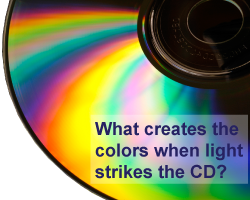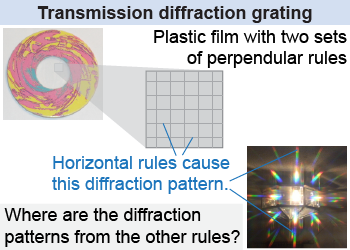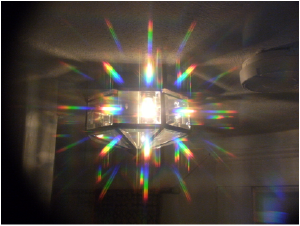|
 Look at a compact disc illuminated by a room light. Do you see different colors or even a rainbow? What causes the different colors of light to bounce off the CD? The compact disc has many tiny grooves or rulings that encode the electronic files or music. When light strikes the surface, these grooves act similarly to a series of tiny slits that diffract and disperse the incident light.
Look at a compact disc illuminated by a room light. Do you see different colors or even a rainbow? What causes the different colors of light to bounce off the CD? The compact disc has many tiny grooves or rulings that encode the electronic files or music. When light strikes the surface, these grooves act similarly to a series of tiny slits that diffract and disperse the incident light. 
|

|
To understand how the CD dispersion works, imagine shining red light through two slits to produce the interference pattern on the previous page. As the number of slits increases, the individual peaks in the interference pattern become sharper. The reason for this sharper pattern is that, with many more slits, there are fewer places at which all the diffraction patterns line up to create constructive interference. This is a feature of diffraction gratings: As the number of slits increases, the lines become sharper. If the diffraction grating is illuminated with white light instead of red light, then a spectrum is formed at the location of each peak. This occurs because each different wavelength of light has its own location on the screen where constructive interference occurs. 
|
 Transmission gratings—made commercially as novelties and toys, such as Rainbow Peepholes™ or Rainbow Glasses®—work by having many little rulings on thin plastic that act as a series of slits. If you look through one of these transmission gratings at a light source, such as a light bulb, you can see a series of rainbow spectra dispersed by the rulings.
Transmission gratings—made commercially as novelties and toys, such as Rainbow Peepholes™ or Rainbow Glasses®—work by having many little rulings on thin plastic that act as a series of slits. If you look through one of these transmission gratings at a light source, such as a light bulb, you can see a series of rainbow spectra dispersed by the rulings. 
|
The CD acts as a reflection grating that disperses light by reflection instead of by allowing the light to pass through it. Reflection gratings are more effective than transmission gratings, so they are more commonly used for scientific research and commercial applications. A spectrograph is a scientific instrument that uses a diffraction grating to disperse light into its spectrum. Spectrographs can be small, hand-held devices, or they can be the size of a large truck when built for the largest telescopes on Earth. 
|

- From the directions of the series of spectra, you can infer the alignment of the rulings—or of the different sets of rulings. Look at the illustration at right: Can you identify the orientation of all the different sets of rules?
- In the illustration you can also see a number of different orders of the diffraction grating. How many can you identify?
 |
- One set of rulings is horizontal to create the vertically dispersed spectra. Another set of rulings is vertical to create the horizontally dispersed spectra. There are two other sets diffraction patterns aligned at ±45°; these are caused by the intersections of the horizontal and vertical rules in directions along the 45° and −45° directions. There also appear to be four other, fainter sets at four different angles; these are likely caused by another set of intersections of the horizontal and vertical rules at angles of ±26.6° and ±63.4°.
- The m = 0 order is in the center and appears white. It is also easy to see the m = 1 and 2 orders in each direction.

|

